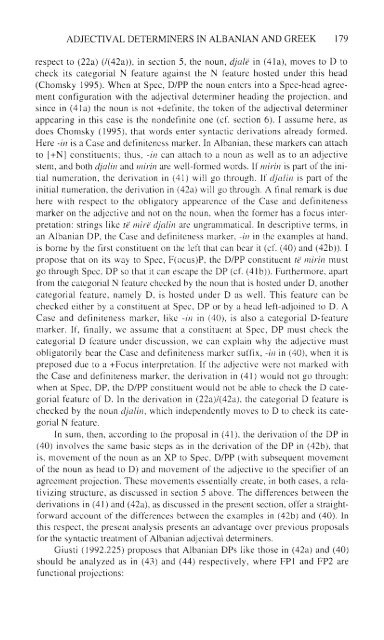Comparative Syntax of the Balkan Languages (Oxford ... - Cryptm.org
Comparative Syntax of the Balkan Languages (Oxford ... - Cryptm.org
Comparative Syntax of the Balkan Languages (Oxford ... - Cryptm.org
- No tags were found...
Create successful ePaper yourself
Turn your PDF publications into a flip-book with our unique Google optimized e-Paper software.
ADJECTIVAL DETERMINERS IN ALBANIAN AND GREEK 179respect to (22a) (/(42a)), in section 5, <strong>the</strong> noun, djale in (4la), moves to D tocheck its categorial N feature against <strong>the</strong> N feature hosted under this head(Chomsky 1995). When at Spec, D/PP <strong>the</strong> noun enters into a Spec-head agreementconfiguration with <strong>the</strong> adjectival determiner heading <strong>the</strong> projection, andsince in (4la) <strong>the</strong> noun is not +definite, <strong>the</strong> token <strong>of</strong> <strong>the</strong> adjectival determinerappearing in this case is <strong>the</strong> nondefinite one (cf. section 6). I assume here, asdoes Chomsky (1995), that words enter syntactic derivations already formed.Here -in is a Case and definiteness marker. In Albanian, <strong>the</strong>se markers can attachto [+N] constituents; thus, -in can attach to a noun as well as to an adjectivestem, and both djalin and mirin are well-formed words. If mirin is part <strong>of</strong> <strong>the</strong> initialnumeration, <strong>the</strong> derivation in (41) will go through. If djalin is part <strong>of</strong> <strong>the</strong>initial numeration, <strong>the</strong> derivation in (42a) will go through. A final remark is duehere with respect to <strong>the</strong> obligatory appearence <strong>of</strong> <strong>the</strong> Case and definitenessmarker on <strong>the</strong> adjective and not on <strong>the</strong> noun, when <strong>the</strong> former has a focus interpretation:strings like te mire djalin are ungrammatical. In descriptive terms, inan Albanian DP, <strong>the</strong> Case and definiteness marker, -in in <strong>the</strong> examples at hand,is borne by <strong>the</strong> first constituent on <strong>the</strong> left that can bear it (cf. (40) and (42b)). Ipropose that on its way to Spec, F(ocus)P, <strong>the</strong> D/PP constituent te mirin mustgo through Spec, DP so that it can escape <strong>the</strong> DP (cf. (41b)). Fur<strong>the</strong>rmore, apartfrom <strong>the</strong> categorial N feature checked by <strong>the</strong> noun that is hosted under D, ano<strong>the</strong>rcategorial feature, namely D, is hosted under D as well. This feature can bechecked ei<strong>the</strong>r by a constituent at Spec, DP or by a head left-adjoined to D. ACase and definiteness marker, like -in in (40), is also a categorial D-featuremarker. If, finally, we assume that a constituent at Spec, DP must check <strong>the</strong>categorial D feature under discussion, we can explain why <strong>the</strong> adjective mustobligatorily bear <strong>the</strong> Case and definiteness marker suffix, -in in (40), when it ispreposed due to a +Focus interpretation. If <strong>the</strong> adjective were not marked with<strong>the</strong> Case and definiteness marker, <strong>the</strong> derivation in (41) would not go through:when at Spec, DP, <strong>the</strong> D/PP constituent would not be able to check <strong>the</strong> D categorialfeature <strong>of</strong> D. In <strong>the</strong> derivation in (22a)/(42a), <strong>the</strong> categorial D feature ischecked by <strong>the</strong> noun djalin, which independently moves to D to check its categorialN feature.In sum, <strong>the</strong>n, according to <strong>the</strong> proposal in (41), <strong>the</strong> derivation <strong>of</strong> <strong>the</strong> DP in(40) involves <strong>the</strong> same basic steps as in <strong>the</strong> derivation <strong>of</strong> <strong>the</strong> DP in (42b), thatis, movement <strong>of</strong> <strong>the</strong> noun as an XP to Spec, D/PP (with subsequent movement<strong>of</strong> <strong>the</strong> noun as head to D) and movement <strong>of</strong> <strong>the</strong> adjective to <strong>the</strong> specifier <strong>of</strong> anagreement projection. These movements essentially create, in both cases, a relativizingstructure, as discussed in section 5 above. The differences between <strong>the</strong>derivations in (41) and (42a), as discussed in <strong>the</strong> present section, <strong>of</strong>fer a straightforwardaccount <strong>of</strong> <strong>the</strong> differences between <strong>the</strong> examples in (42b) and (40). Inthis respect, <strong>the</strong> present analysis presents an advantage over previous proposalsfor <strong>the</strong> syntactic treatment <strong>of</strong> Albanian adjectival determiners.Giusti (1992.225) proposes that Albanian DPs like those in (42a) and (40)should be analyzed as in (43) and (44) respectively, where FP1 and FP2 arefunctional projections:
















